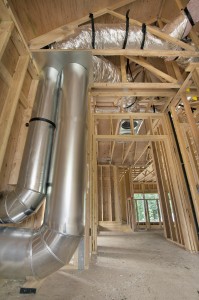 Most homes in the Beaverton, OR area use centralized furnaces to keep their homes warm in the winter and air conditioners to keep them cool in the summer. Those systems rely upon a series of ducts branching out from the central system itself to the various rooms in your home. Conditioned air (either hot or cold) moves through the ducts, which keeps the temperature steady and ensures that the whole house is heated evenly. Ducts are usually placed in the crawlspace of the walls, the attic, or similar hidden locations. This has the benefit of keeping them safe from harm, but leaks do spring up, and even breaches can affect you from time to time. The good news is that a trained service can usually repair the damage quickly. But before that happens, you need to be able to spot the signs that something is amiss.
Most homes in the Beaverton, OR area use centralized furnaces to keep their homes warm in the winter and air conditioners to keep them cool in the summer. Those systems rely upon a series of ducts branching out from the central system itself to the various rooms in your home. Conditioned air (either hot or cold) moves through the ducts, which keeps the temperature steady and ensures that the whole house is heated evenly. Ducts are usually placed in the crawlspace of the walls, the attic, or similar hidden locations. This has the benefit of keeping them safe from harm, but leaks do spring up, and even breaches can affect you from time to time. The good news is that a trained service can usually repair the damage quickly. But before that happens, you need to be able to spot the signs that something is amiss.
Why Are Leaking Ducts a Problem?
A leak or a breach in your ducts means that the conditioned air your furnace is working so hard to produce is not actually going where it needs to. That can reduce the effectively of the heating system, forcing it to work harder and longer to do its job. In the process, your monthly heating rates go up and the added stress on the system means a higher chance of breakdowns and repair calls. Depending on the nature of the leak, it could pull dust and dirt from your crawlspace into the ducts as well, lowering your indoor air quality and drawing increased risk of illness to your family.
How to Spot Them
Spotting problems with your ducts can be tricky, since they’re hidden behind the walls or in the attic in most cases. The problem can sometimes linger for months unless you know what to look for. Symptoms of leaking or breached ducts can include (but are not limited to) the following:
- Humming or whistling noises coming from strange spots in the house. The noises will usually start and stop with the starting and stopping of your heater.
- Warm spots on the walls, floor or ceiling, where hot air is blowing from the leak. (It will be a cold spot if you’re running your air conditioner instead of your heater.)
- Reduced air flow coming out of the vents, as air is diverted through the leak or breach.
- Lowered heat levels from the breach, as the heated air is diverted from its path.
- Unexpected spikes in heating bills as the system struggles with the new burden.
What to Do
Never attempt to repair leaky ducts yourself. It takes trained professionals using the right equipment to do so. (It may sound ironic, but duct tape is actually useless in repairing ducts, since it can’t stand up to the temperature changes.) Instead, the moment you detect something is amiss, shut the system down and call in a trained service to pinpoint the source of the leak and quickly make repairs.
The friendly team at Clean Air Act, Inc. can perform duct repair services for you!
